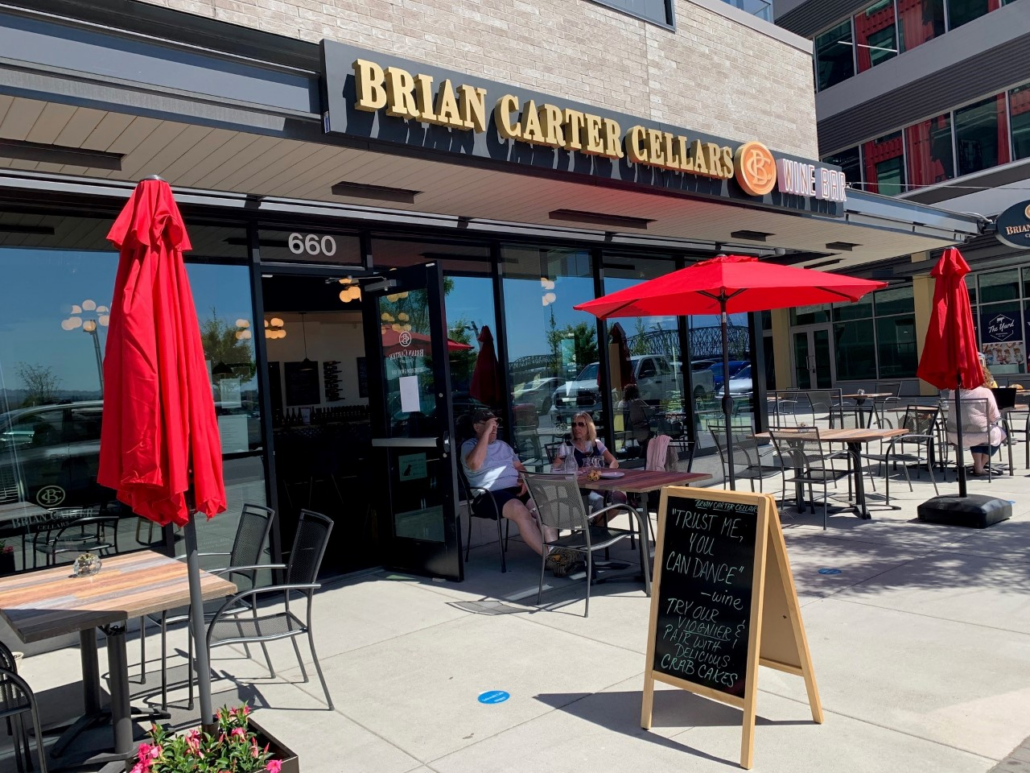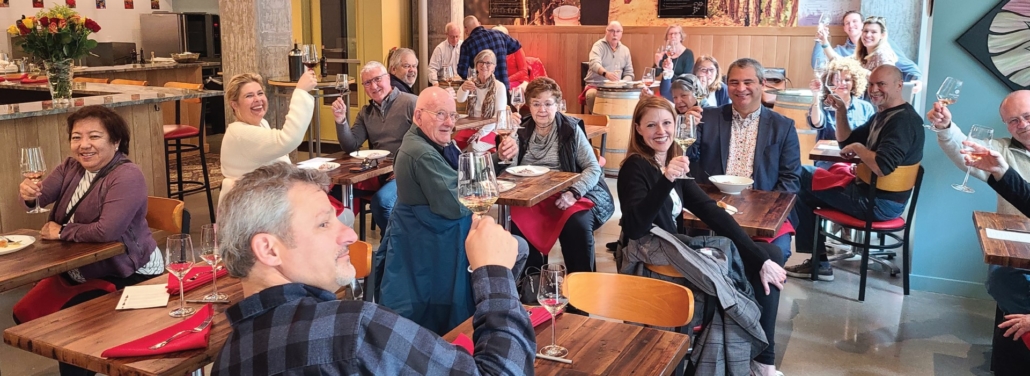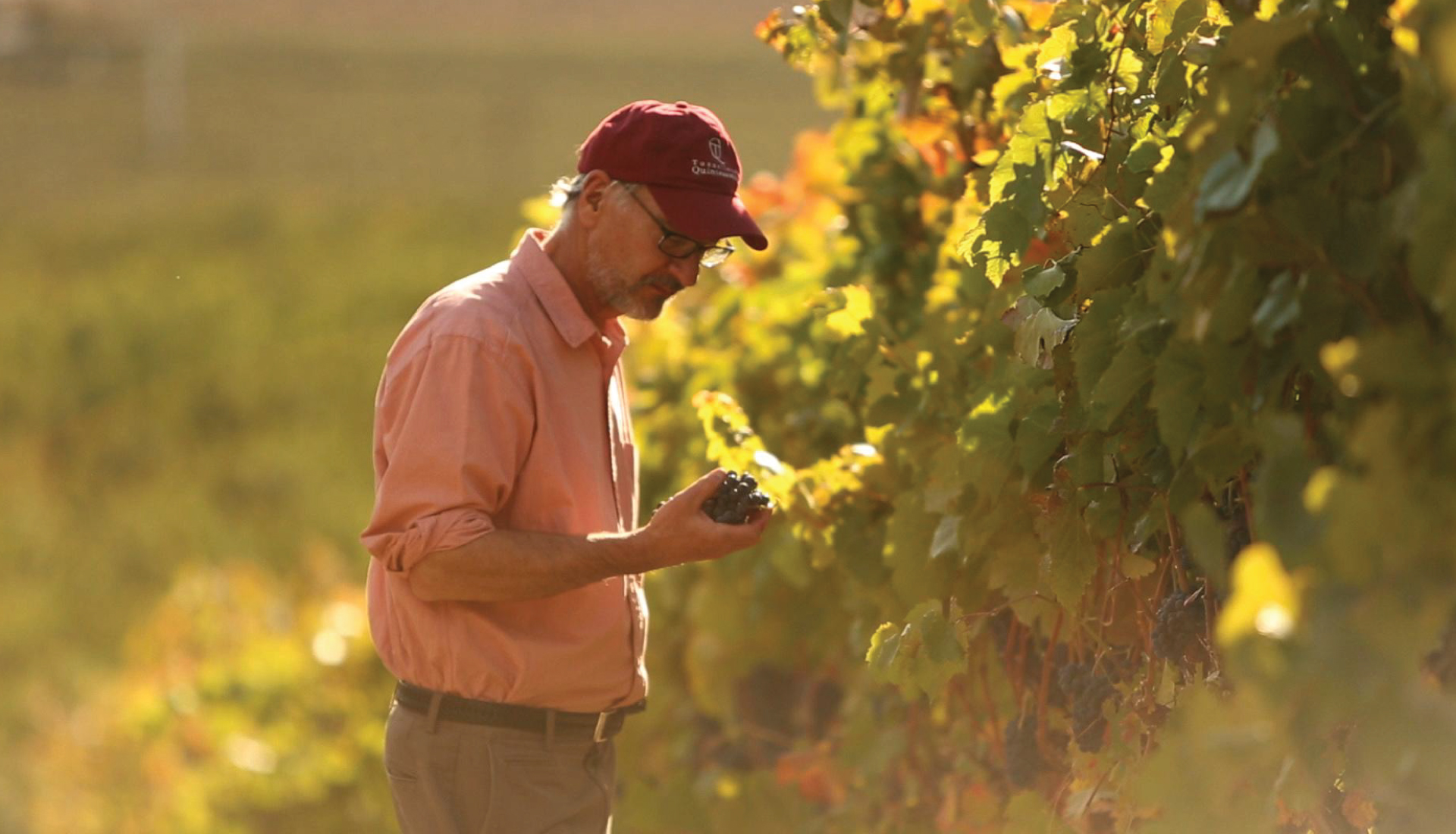Brian Carter, the Man Whose Name is on the Label,
Manages Every Detail of His Award-Winning Winery
With tasting rooms in Woodinville and Vancouver, WA., Carter has made
his reputation by creating unique, different and varying blends for 45 years.
By Mark Storer

The ribbon cutting ceremony for Brian Carter Cellars current tasting room in Woodinville’s Woodin Creek Village took place on March 16, 2022. Taking part in the ceremony, from left to right, were: Kimberly Ellertson, Executive Director of the Woodinville Chamber of Commerce, Sunshine Grato, the then Woodinville Tasting Room and Bistro Manager, Brian Carter, Nicholas Ames, Brian Carter Cellars Woodinville Chef, Woodinville Mayor Mike Millman and Barb Larimer, Sales & Marketing Director for Brian Carter Cellars.
Sitting on the patio at Brian Carter Cellars bistro in downtown Woodinville, WA.,on a sunny day, it’s very easy to fall into the trance of a luscious blend in the glass, several plates of exquisitely crafted tapas within reach, and a quiet afternoon with nothing in particular beyond your senses demanding your attention. In this case, we were sitting with Brian Carter himself, and even he seemed enchanted enough to enjoy the moment.
It’s also easy to forget what it took Carter, a founding-era winemaker in Washington, to get here. After all, Carter’s winery has been named Pacific Northwest Winery of the Year for 2023 by Great Northwest Wine magazine. His wines consistently earn 90 or more points, with his 2018 Abracadabra red blend earning 95 points from the Great Northwest Wine Invitational.
James Suckling awarded three of his wines at 92 points from 2016, and no less than nine of his wines won Platinum awards from Great Northwest Wine magazine in 2021. The awards and accolades are welcome and wonderful, but Carter is simply doing what he has wanted to do for 45 years, and that is to make great wine.
But of course, running a small but growing business, with a growing list of employees, managing the numbers, and contracting for the fruit all while focusing on making wine, is not as easy as it looks–though Carter wouldn’t have it any other way. “One day I might be out selling wine. One day I’m talking to a wine writer and one day I’m doing the numbers,” he said. “But then I get to make wine once in a while,” he laughs. “I’m just getting into this season’s blending trials, pulling samples, the first ones of the year.”
Carter will spend a good deal of time choosing various barrels for blending and developing flavor profiles for what will become this year’s vintage bottles.
His passion for wine and creating unique, different and varying blends, goes back farther than that, according to Carter. “When I was 12 years old, I was given a microscope by my parents and I was running around in ditches, and looking at
amoebas under the microscope,” Carter said. He got interested in looking at yeast under the lens, and one day, he was picking blackberries with his mother near their home in Corvallis, Oregon. “I was told that if I wanted to look at yeast, I had to start a fermentation, so I did one using some blackberries, looked under the microscope and there they were. I like to say that I’ve been having the little buggers work for me ever since.”

Long time fans of Brian Carter Cellars will remember the one-story house located in Woodinville’s Hollywood District that served as the winery’s tasting room from early 2006 through Sept. of 2021. It had a large back deck where guests could relax and enjoy flights of Brian Carter wines.
That love of yeast and what it can do remains a large part of Carter’s winemaking. He almost always avoids saccharomyces, which is the primary yeast most winemakers use, and for his red wines particularly, relies on the natural yeasts that can be found on the fruit while it’s growing. Carter says that in doing so, he’s had to unlearn a few things he learned while taking classes at UC Davis in oenology.
While in college at Oregon State University where his father was on the faculty, and where he earned a degree in microbiology, he was introduced to winemaking and said he was hooked. “I took a class in wine appreciation in my junior year, and we visited winemakers in the Willamette Valley and we met David Lett, Bill Fulmer and Dick Erath, and all these guys and I saw what they were doing, and I thought it was cool,” Carter said. “David Lett took me under his wing a little bit and he told me I should go to UC Davis, and so I went.”
Carter worked in California for a couple of years primarily at Chateau Montelena, the famed winner of the 1976 Tasting of Paris with their Chardonnay. “I worked there while I was going back and forth to Davis, but I always intended to come back to the Pacific Northwest,” he said.
Carter knew the Oregon wine industry fairly well. As he said, “the three primary wine grapes then were Pinot Noir, Pinot Noir, and Pinot Noir and I didn’t necessarily want to focus on that. But I met David Lake at Davis and I was intrigued about what was happening in Washington State.” Carter came to Washington and learned from a number of winemakers about the variety of wines produced in the state. “California has Cabernet, and Oregon has Pinot, but Washington’s story is that we grow a lot of different varietals and we do them well,” he said.
He spent time getting to know wineries in places like Prosser, Yakima and Walla Walla, but he didn’t want to live in the eastern portion of the state. “I was more interested in living on the west side of the state than the east side, and so I spread the word that I was interested in working here.”
A winemaker named Paul Thomas, who made wine in Bellevue, and remains a good friend of Carter’s, came down to California to meet him and hired him as winemaker for Paul Thomas winery. “That was August of 1980 and at the time, there were 16 wineries in Washington,” Carter said. Today, by comparison, there are well over 1,000 wineries in the state.
It was the heyday and the beginning of Washington wine with new varietals being planted, and winemakers and vintners experimenting with crops. By 1986, Syrah made its debut in Washington at Red Willow vineyard and was championed by the likes of David Lake and Dick Boushey and is now the third most popular varietal grown in the state.
Carter worked for Thomas for eight years, and then began to branch out on his own to do consulting. He was the first winemaker at Hedges Family Estate and worked for Silver Lake Winery as well as McCrea Cellars, among others. In all of these places, he made award-winning wines and left a trail of positive reviews.
In the 1990s, he wanted to try his hand at making wine under his own label, and in 1997, he was able to do that while consulting with Apex Cellars on their Washington Hills project. “I didn’t go off on my own until 2004, and in 2006 Brian Carter Cellars opened in a one story house in Woodinville,” Carter said.
The wines Carter makes are unique in that he spends much of his time blending varietals more often than simply releasing varietal wines. To be sure, he does both, but even some of his varietals are unique, like an absolutely luscious Souzao with a deep, dark, and rich color and characteristic black currant and spice flavors. Carter makes a number of wines with Portuguese grapes, all grown in Washington, like Tinto Cao and Touriga Nacional, among others, as well as Spanish grapes like Tempranillo and Garnacha.

Brian Carter opened a satellite tasting room on the Columbia River waterfront in Vancouver, WA. in March of 2022. It has been a way to introduce his wines to a whole new customer base.
Like his blended wines, Carter is something of a winemaker blend himself. “I’m a scientist, a microbiologist and so I guess I start there,” he said. “My cellar is full of European wines and I try to go to Europe every year.” Carter had just gotten back from Portugal when we spoke. “That’s where it all started. Most of these great wines started in Europe and most winemakers spend their time looking over their shoulder at where these great wines came from,” Carter explained.
The great wines also pair well with great food, and that is a serious subject for Carter, who says that if he wasn’t a winemaker, he’d probably be a chef. He loves cooking. “When people ask me what my favorite wine is, I often say it depends on what I’m having for dinner. Food is really the culmination of my experience with wine. It’s healthier, and it’s even safer.”
To that end, Carter’s Woodinville tasting room is also a bistro with a tapas style menu of delicious foods like stinging nettles risotto, made with nettles that Carter himself harvests. Plates of Hamachi tuna crudo, salt cod fritters, and braised short ribs pair beautifully with Carter’s sublime wines, like Byzance, a Chateauneuf du Pape like Rhone blend of five grapes, and Trentenaire, a Bordeaux blend with 56% of the blend in Petit Verdot as the dominant grape and only 12% Cabernet Sauvignon.
When pressed, Carter works his way with passion into why Syrah might be the “easiest” wine to make (“it’s indestructible”), and Grenache might be the hardest (“it’s temperamental”). He then steers the conversation easily into designing labels for each wine, and which printer he’ll use for the labels. He envies the calm of a winemaker in Madeira, Portugal he met on his recent trip who said he doesn’t worry at all about money, or day to day operations. “They’ve got a cellar of wines that dates back to 1907, and so inventory isn’t an issue for them,” he said.
Carter’s sense of the science of wine mingles into the art he practices as a wine blender. Noting that while certainly a winemaker has to pay attention to acids and tannins in the various blends, he said there is more art than science to the practice. “I rely primarily on what it tastes like,” Carter said. As he speaks, we taste a sample of one of his blends, a Rosé dominated by Sangiovese. It is a relatively rare rosé that not many wineries produce and it is a perfect summer wine, with a depth of flavor that lends itself well to cheeses and dried fruits.
Carter makes all of his wines at the Columbia Winery facility in Woodinville, and has since 2009. Before that, he made his wines in rented-out winery spaces including EFESTE in Woodinville. Carter also leased a 2,000 square-foot house in Woodinville that served as his primary tasting room. The house had a large back porch and was perfect for hosting his guests, and for a time, he considered purchasing the property, but the recession of 2007-08 killed the deal.

Guests toast in unison to the good wine and great time they are experiencing at a recent wine club party at Brian Carter Cellars Woodinville tasting room. Smiles on faces is why Brian has been making wine for 45 years.
Carter even held grape stomps for customers at the rented house in the early days. “We had a couple of old barrels and drilled holes in the bottom of them,“ he explained. “People would come and get to share in the process, which was all great fun.” He knew he couldn’t keep the practice going when it became apparent that injury or damage could occur, and he didn’t want to leave open that possibility.
Since Columbia Winery left its namesake facility, he’s currently the only winemaker there. The Woodinville tasting room and bistro is located in Woodin Creek Village in Woodinville, and he has a tasting room on the Columbia River waterfront in Vancouver, WA, which opened in July, 2020 . “Most Washington winemakers have figured out that direct-to-consumer is the best business model, and so the idea was to open up a new tasting room to introduce the wines to a new customer base,” Carter said. “I considered a lot of places, including downtown Seattle, in Sodo, and I even considered Portland for a while.”
But the idea of opening another King County tasting room, or getting an Oregon wine-making license didn’t appeal to him. “I was the second winery to move into the waterfront there in Vancouver, and it really is a beautiful spot,” he said. The wines are also available at the Wines of Washington tasting room at Pike Place Market in downtown Seattle.
After we worked our way through Carter’s history and philosophy of winemaking, another winemaker came to the table and introduced himself. Carter welcomed him and invited him into our conversation, and the two shared ideas and philosophies about everything from racking, and when it’s best to top barrels to when it’s best to pick various types of grapes from Red Mountain. All the while, Carter pours tastes of a number of his blends. La Coursier, Byzance, Solesce and Trentenaire and others. The blends are unique, and subtle — each one a creative project, with a profile that differs from so many other Washington wines.
Carter sources his grapes from about a dozen different vineyards in Eastern Washington, from the Wahluke Slope in the northeast part of the state to Horse Heaven Hills closer to the Oregon border. “I’ve been through 43 vintages in Washington,” he said. “And a lot has changed. I’ve definitely seen changes in the climate — though not all of them are bad and that doesn’t get said enough.”
But Carter himself has also changed over time, and he has created wines that have earned their place at the top of the Pacific Northwest among more than 2,000 wineries from Oregon to Washington to Idaho.
For a guy who started off with a microscope and a few blackberries, Carter’s winemaking story has become the stuff of legend.
One of the best ways to experience the variety of Brian Carter Cellars wines is to join one of the winery’s four wine clubs. Wine club members receive a host of benefits, including invitations to specially curated release food and wine events, priority access to limited production wines and library vintages, complimentary tastings at both tasting rooms, invitations to special events throughout the year, as well as discounted pricing on bottle and case purchases.
For more information about each of the four wine clubs, visit: www.briancartercellars.com/wine-club.
Brian Carter Cellars tasting room in Woodinville is located in the Woodin Creek development at 17140 135th Ave. N.E., Suite 1030. Phone: (425) 806-9463. The winery’s Vancouver tasting room is located at 660 Waterfront Way. Phone: (360) 216-1444.
If you can’t get to either tasting room this summer, all of Brian Carter Cellars current releases wines can be purchased by visiting the winery’s online store at: www.briancartercellars.com. When the site opens, click on the tab at the top of the Home Page that says: “Purchase Wines.”


